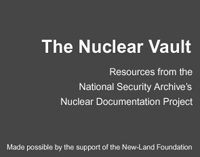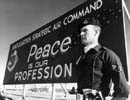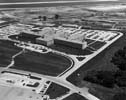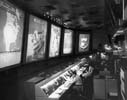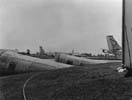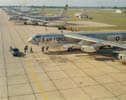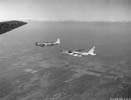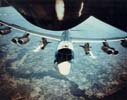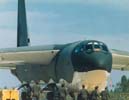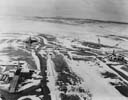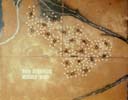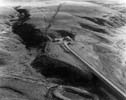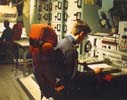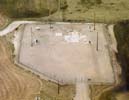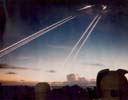home | about | documents | news | publications | FOIA | research | employment | search | donate | mailing list
Photo Gallery
One of the many wonderful resources at the National Archives at College Park is the Still Pictures Division, which holds countless photographs and negatives produced by many U.S. government agencies over the decades. For researchers of the nuclear era, the U.S. Air Force's photo collection is an especially valuable resource because it documents the many aspects and phases of that service's nuclear role, from the 1950s through the late 1970s. The collections of Army, Navy, and Defense Department photos are also significant. Some Air Force photos may be seen elsewhere in the "Nuclear Vault," but to show further the value of this, and other collections in the Still Pictures Division, the "Vault" will periodically display collections of some of the more note-worthy nuclear-related material from the Still Pictures Division. The first portfolio will covers the multi-faceted activities of the Strategic Air Command [SAC], whose second Commander-in-Chief, the controversial General Curtis LeMay, vowed to turn into a "cocked pistol," ready to strike the Soviet Union at a moment's notice. The following 20 photographs show a variety of SAC installations and operations, including headquarters at Offutt Air Base and the underground command post, as well as bomber and missile forces and deployments, including alert activities.
Source for all images: National Archives, Still Pictures Division, RG 342B [Photos in this collection are cited by box number below. Descriptions are from original Air Force captions.]
Click on the thumbnails below for larger images.
Image 1 - Security Guard - "S/Sgt Billy Davis, a sentry, stands guard at the entrance to the Headquarters facilities of the Strategic Air Command, Offutt Air Force Base, Omaha, Nebraska." Circa June 1959. (Box 434)
Image 2 - Headquarters - "Nerve center of SAC's global strike force is its headquarters at Offutt Air Force Base near Omaha, Nebraska. The three-story administration building shown here is connected by underground ramps to a three-story control center buried 45 feet beneath the earth. On the roof of the central wing of the administration building is the 'Snifter,' an electronic device capable of detecting radioactivity within a 50 mile radius. ? Detection of radioactivity would automatically set off an alarm in the underground control center and trigger a chain reaction to make the underground building completely independent of the outside world." Circa December 1958. (Box 295)
Image 3 - Underground Command Post I - "A view of Command Post at Headquarters, Strategic Air Command, Offutt Air Force Base, Omaha, Nebraska where television facilities send up-to-the minute information to help Commands." Circa February 1961. (Box 295)
Image 4 - Underground Command Post II - "A new visual display system, designed to expedite command and control of [SAC's] far-flung retaliatory force, is in operation ?. Large screens [present] information on weather conditions, force deployment, aircraft and missiles, plus a multitude of other operational data, can be projected on the screens as desired to aid the commander in chief and his battle staffing making vital decisions promptly and accurately. Incoming data from a nearby battery of computers that link SAC's global network of bases can be processed and projected for viewing within 30 seconds." Circa February 1961. (Box 295)
Image 5 - The Red Telephone - "The famous 'Red Telephone' - key to the primary alerting system in SAC Headquarters underground command post -rests on the desk of the senior controllers. By picking up this phone, the controller can be placed in instantaneous voice contact with every SAC command post at bases throughout the world." Photo taken circa June 1959. (Box 434)
Image 6 - Airborne Command Post - "An airborne command post, capable of directing [SAC's] global armada of war planes and missiles is now operational. Five specially equipped Boeing KC-135 jet tankers, in the event SAC's underground battle headquarters at Offutt Air Force Base, Nebraska, becomes inoperative due to bombing, can immediately communicate with any agency, commander, country or bomber in the world - and direct combat activities. Each of the five Stratotankers, which were converted for airborne command purposes, will have a control team headed by a general officer, four officers, three airmen, and crew. One aerial battle headquarters aircraft, which flies within radar range of Offutt, is on fifteen-minute alert basis, 24 hours a day." Photo taken circa early 1961. (Box 295)
Image 7 - General Curtis LeMay - SAC's second commander-in-chief (1948-1957), LeMay played a crucial role in developing the capabilities of his command so that it could launch an atomic offensive at short notice. LeMay had shown his organizational and command abilities during World War II, when he directed mass bombing operations against Japanese cities, including the fire bombing of Tokyo in March 1945. LeMay is shown here "[taking] a break for a cigar during flight operations aboard [the aircraft carrier] the USS Midway ([CVA-41). General LeMay is on board, along with 50 high-ranking NATO officials for a one day cruise designed to portray the Sixth Fleet in action." (Box 507)
Image 8 - General Thomas Power - SAC's third commander-in-chief (1957-1964), Power presided over the integration of intercontinental ballistic missiles-consisting first of Atlas, then Titan and Minuteman, missiles-into SAC's forces. Power, like his successors, began wearing a second hat in 1960 when he became the first director of the Joint Strategic Target Planning Staff (JSTPS). Located at Offutt Air Force Base, the JSTPS has had responsibility for preparing the SIOP (Single Integrated Operational Plan), the U.S.'s body of plans for strategic nuclear war. Here he is shown "[making] a point during a briefing in the underground command post" at SAC headquarters. The chart mentions "Reflex Action" which was a SAC program to deploy alert B-47 bombers at bases in Spain, the United Kingdom, and Morocco. (Box 434)
Image 9 - B-47 - The bombers are parked at Sidi Slimane Air Base, then French Morocco, circa August 1954. Two years earlier, in January 1952, President Truman approved the deployment of non-nuclear components of nuclear weapons at U.S. bases in Morocco, but the French were not told about this. In April 1954, President Eisenhower approved the deployment of complete nuclear weapons at SAC bases in Morocco. (Box 1479)
Image 10 - Alert Scramble I - A SAC B-47 "alert crew board their aircraft during a practice alert at Offutt Air Force Base, Omaha, Nebraska." Circa April 1960. Through much of the Cold War, SAC tried to keep a significant portion of its bomber force on a 15 minute ground alert so that the bombers could go airborne, or fly to a satellite base, in the event that a Soviet missile attack has been detected. (Box 433)
Image 11 - Alert Exit Tunnels - "Out of these tunnels will stream the alert crews as they respond to the alert buzzer. No matter where they are in the area, their rooms, or the lounges, the buzzer gets immediate response. In the background area the KC-135 Stratotankers the crews man." Castle Air Force Base, circa July 1960. (Box 433)
Image 12 - B-52s On the Line - "3/4 front view of B-52s on the line, armed with AGM-28 Hound Dog Missiles as air crew ? enters first aircraft." Photo taken in 1967. (Box 688)
Image 13 - B-52 Refueling I - "One of the mightiest weapons in America's arsenal is the U.S. Air Force's giant Boeing B-52 Stratofortress. The first wing of these inter-continental bombers is now operating at Castle Air Force Base, Merced, California, and additional wings are forming as crews complete training and aircraft are delivered." In this photo, "a Boeing KC-97A tanker plane refuels a giant Boeing B-52 ? during a training flight." Circa April 1956. (Box 669)
Image 14 - B-52 Refueling II - "USAF B-B52H with Hound Dog Missiles approaching refueling boom." Circa November 1963. (Box 690)
Image 15 - Alert Scramble II - "An aircrew of the 28th Bomb Wing scramble to their B-52 aircraft during an alert mission." Ellsworth Air Force Base, South Dakota, July 1975. (Box 688)
Image 16 - Atlas ICBMS - "Convair SM-65 Atlas intercontinental ballistic missiles in firing position at Launch Site A, Warren Air Force Base, Wyoming, the nation's first fully operational missile base." The site became operational in June 1960; this picture was taken later in the year. (Box 306)
Image 17 - Minuteman Missile Sites - Overhead view of Minuteman III Missile site - "Artist's conception of Minuteman III missile site complex (aerial view), 98th Strategic Missile Wing 9SAC), Warren Air Force Base, Wyoming. Circa 1980. (Box 969)
Image 18 - Minuteman I Launch Control Center I - "Out on the wind-swept prairie beyond Great Falls, travelers on the main highway pass one of 15 launch control facilities of the Montana Minuteman complex. These facilities are on the hubs of widely-dispersed rings of missile launchers. They house security forces, a small housekeeping crew and a two-man missile combat crew. Some fifty feet below in a hardened steel and concrete launch control center capsule, one of these crews is on constant alert, monitoring the readiness of their flight of 10 missiles." Circa December 1962. (Box 888)
Image 19 - Minuteman III Launch Control Center II - "Interior view of the launch control center, with personnel performing their operational duties." Ellsworth Air Force Base, South Dakota, March 1976 (Box 922)
Image 20 - Minuteman III Launch Facility Site - "High angle view of the Minuteman III Launch facility site Sierra 34, shown from the front entrance, Malmstrom AFB, Montana." Circa July 1979. (Box 936)
Image 21 - Test of Multiple Independently Retargetable Re-entry Vehicles - "Six unarmed Minuteman III Mark 12 reentry vehicles are shown approaching targets near Kwajalein Atoll in the Western Pacific Ocean. The [photo was] taken during an operational test of two Minuteman III ICBMs launched from Vandenberg AFB, Ca., on July 10, 1979 as part of the Strategic Air Command exercise Global Shield '79." (Box 967)
